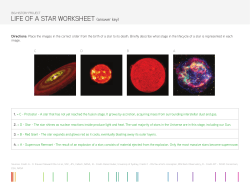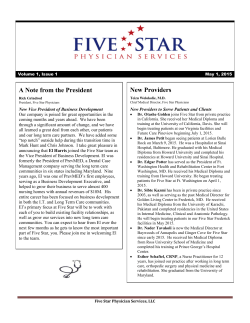
Lecture 10
PHYS 3160 Lecture 10 – White dwarfs and neutron stars Textbook reference: pp. 208-‐217 Last ;me: High-‐mass evolu;on and supernovae Today: What’s leF? White dwarfs and neutron stars/pulsars Crab Nebula – supernova remnant from 1054 AD explosion PHYS 3160 Lecture 10 – Stellar remnants Textbook reference: pp. 208-‐217 Revision – Friday 24 Oct What topics do you want? Tues 21 Oct – Black holes and any other interes;ng things you like. Now taking sugges;ons! White dwarfs: Observa;ons AFer a low-‐mass star blows off its planetary nebula, the degenerate core remains. This core is hot, but no nuclear reac;ons are happening (supported only by electron degeneracy pressure). So it cools, forever. High T, low L (recall these cores are small, ~Earth radius) Sirius B Sirius Black White dwarfs: Observa;ons KOI-‐256 Eclipsing WD+M dwarf system R = 9361 ± 633 km M = 0.592 ± 0.084 Msun Teff = 7100 ± 800 K Muirhead et al. (2013) ApJ 767, 111 White dwarfs: Observa;ons Observed WDs and cooling track (from Chabrier et al. 2000). Why a sudden cutoff in age? The universe is not old enough! Structure of white dwarfs Recall that a low-‐mass stellar core is composed of degenerate C/O. As ;me passes ever on, the naked core can do nought but cool. Low T and high density more and more degeneracy. Pgas ~ K1ρ5/3 non-‐rela;vis;c Pgas ~ K2ρ4/3 rela;vis;c, when momentum p0 >> mec Really, there is a transi;on from one to the other: Pgas = f{(1+X)ρ} where f is a func;on changing from the non-‐rela;vis;c one to the rela;vis;c one above. X is the hydrogen mass frac;on. Structure of white dwarfs Most common Degeneracy Radii of white dwarfs Pack on more mass, it gets smaller! Radii of white dwarfs Gravity pulls outer layer inward, pressure pushes them out. This is the eternal struggle a star faces. For degenerate maner, P is essen;ally constant, but piling on more mass always increases gravity. Gravity wins and the star shrinks. (This also happens with degenerate brown dwarfs and planets) Wait a minute… If it gets smaller at higher mass, the radius must go to zero some ;me! What’s that all about? Chandrasekhar limi;ng mass Solving WD structure equa;ons to get maximum mass possible: Mcrit = 1.44(1+X)2 Msun This makes it look like you could have X=1 M=5.76 Msun? Remember that such a massive star would burn most of its H (convec;ve core) and lose envelope H to stellar wind. It turns out white dwarfs have very linle hydrogen, apart from a thin veneer on the surface, e.g. “DA” type white dwarfs. So for X~0, Mcrit = 1.44 Msun Supported by observa;ons – no WD of greater mass has been found. Most WDs are ~0.6 Msun, probably due to (poorly-‐understood) mass loss process. Chandrasekhar limi;ng mass You can’t go this far and not go further! MCh=1.44M Recall the Chandrasekhar mass is the maximum possible mass for a white dwarf star. An isolated WD cools off with measured rela;on and fades for rest of ;me. If we add mass to a WD to push it over MCh then it will become unstable. The mass comes from an accre;ng binary companion in a close interac;ng binary system. Companion star expanding to fill its Roche Lobe WD with mass close to MCh “Roche lobe” : region within which maner is gravita;onally bound to the star. The Roche lobe of the primary and secondary meet at the Langrangian point. Maner can be transferred. Roche lobe is gravita;onal equipoten;al surface Chandrasekhar limi;ng mass You can’t go this far and not go farther! Once MCh reached then e– degeneracy pressure no longer enough to hold star up: → C ignited under degenerate condi;ons -‐ nuclear burning raises T but not P → Thermonuclear runaway → Incinera;on and complete destruc;on of star Exceeding the Chandrasekhar mass
There are three models for accre;ng the required maner -‐ none of them are yet proven 1.
WD + main-‐sequence star companion: slow accre;on of mass from a binary companion on the main-‐sequence e.g. cataclysmic variable systems (M~1M and below). But observed accre;on rate is slow, ;mescales possibly too long e.g. U Scorpii (recurrent nova) MWD=1.5±0.2M MMS=0.9±0.2M 2.
WD + red giant: the ini;ally more massive star becomes WD. The lower mass companion (~1-‐2M) evolves into red giant. Mass transferred to WD. Such systems are well known to produce novae. But mass transfer must be at just the right rate. 3.
WD+WD merger (double degenerates): merging of two WD in binary systems, We see WD binary systems. e.g KPD 1930+2752: Mtot=1.47±0.01M : loses angular momentum by gravita;onal radia;on, merges within 200 x 106 yrs Image Credit: Don Dixon Hillebrandt & Roepke (2006) Scien;fic American 295, 42. Neutron Stars Recall the collapse of a massive star results in a degenerate core of neutrons ~30 km radius. AFer the supernova explosion (core-‐collapse, Type II), the neutron star remains. This happens for core masses > 1.44 Msun (progenitor mass cutoff uncertain) Also possible for a WD to accrete mass and collapse into a neutron star without undergoing a Type 1a SN explosion. Neutron Stars: crust and chewy centre This is the “neutronium” they talk about in Star Trek. Equa;on of state: cannot be tested by experiment, and theories are all over the shop. Maximum mass somewhere between 2-‐2.5 Msun. Pulsars The stars, not the Nissan How do we know neutron stars exist? Very ;ny and low luminosity! 1960s: Discovery of a “pulsar” – periodic bursts of radio waves every 1.33 seconds. Ini;ally labeled “LGM” for Linle Green Men. Since then we have found pulsars at all sorts of periods, in many wavelengths (visible, X-‐ray, gamma rays). Pulsars The stars, not the Nissan For something to rotate that fast, it must be very small so no veloci;es exceed c. Discovery of Crab Nebula pulsar, period of 33 milliseconds, proved that pulsars must be neutron stars. Nothing else could be that small. Max rota;on 0.3 ms period Fastest known: 1.6 ms Hubble Telescope op;cal image + Chandra X-‐ray image of Crab pulsar. Magne;c Fields Big. Really big. Mind-‐bogglingly big. Dynamo effect from heavy-‐nucleus superfluid. Field strengths ~ 108-‐1011 Tesla Could rip the iron atoms from your blood directly through your skin, from 100s of km. The Hulse-‐Taylor Pulsar 1993 Nobel Prize in Physics A binary pair of pulsars! General rela;vity predicts energy loss from gravita;onal radia;on. That radia;on should cause the pulsars to spiral into each other as their orbits decay. Observed period decrease fits GR predic;on EXACTLY Pulsar ;mings Really Useful Stars The pulses come at extremely regular intervals. The periods can be measured to ludicrous precision. e.g. PSR J0437-‐4715 (van Straten et al., 2001) P = 5.757451831072007 + 8x10-‐15 ms not a typo! This makes pulsars the best clocks in the universe* *though now the best atomic clocks are comparable in precision. What can you do with a clock in space? See if things are orbi;ng it. Oh, and sensi;ve tests of general rela;vity, too. But, planets! Pulsar ;mings Really Useful Stars Wolszczan & Frail, 1992, Nature, 355, 145. 0.02, 4.3, 3.9 Earth masses! Wrapping it up What kind of stars become WD and NS? < 8 Msun White dwarf 8-‐25ish Msun Neutron star > 25ish Msun Black Hole Uncertain;es come from the extent of mass loss and dependencies on ini;al chemical composi;on. For fun short stories about neutron stars, see “Neutron Tide” by Arthur C. Clarke and “Neutron Star” by Larry Niven. hnp://shaggy-‐dogs.briancombs.net/4776/neutron-‐;de
© Copyright 2025









